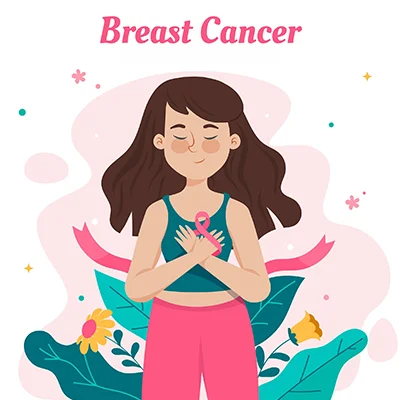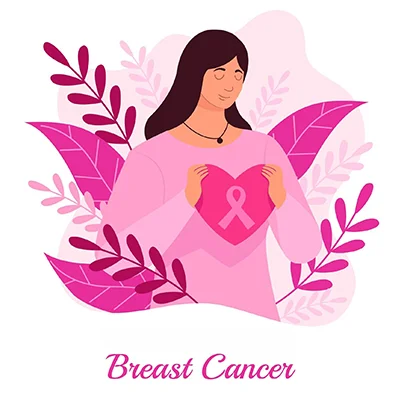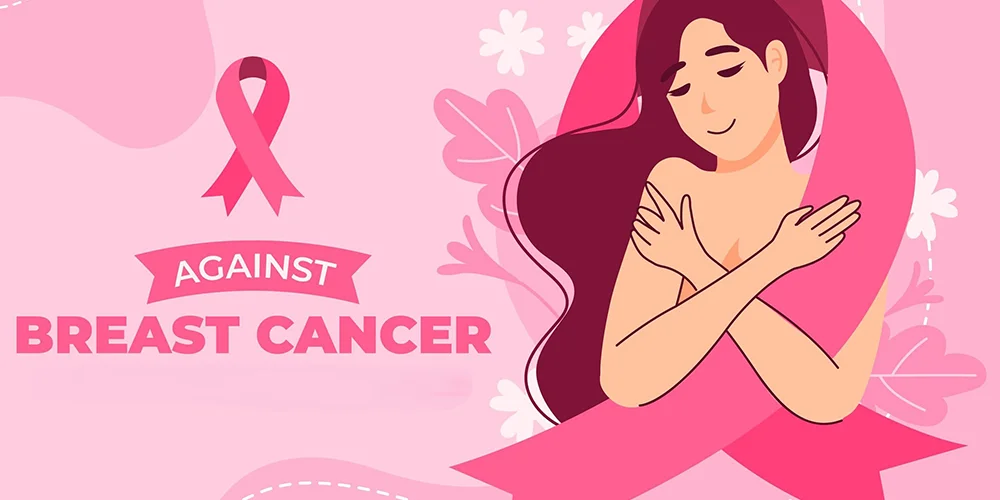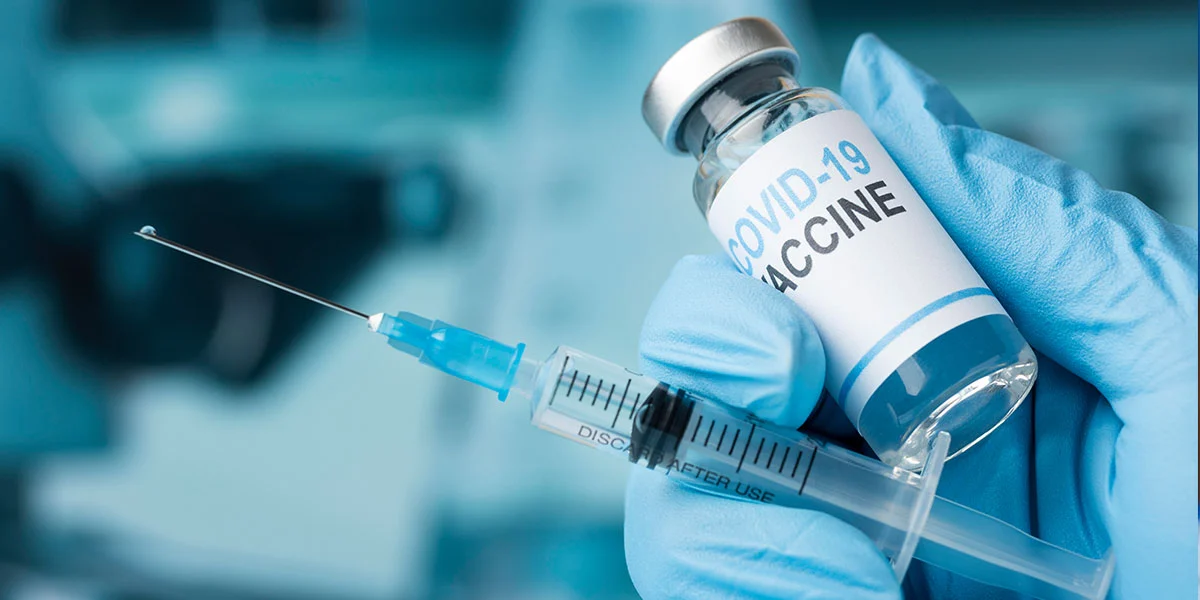Breast Cancer: Types, Symptoms, Causes, & Prevention is a malignant (cancerous) tumor that originates in the cells of the breast tissue. It primarily affects the cells lining the milk ducts (ductal carcinoma) or the lobules (lobular carcinoma) responsible for producing milk. Over time, these cancerous cells can invade nearby tissues and, in advanced stages, spread to other parts of the body through the bloodstream or lymphatic system.
Breast cancer is the most common cancer diagnosed in women worldwide and can also affect men, although it is much less common in males. The exact causes of breast cancer are not fully understood, but it is believed to involve a complex interplay of genetic, hormonal, environmental, and lifestyle factors. Early detection through regular breast self-exams, clinical breast exams, and mammograms can significantly improve the chances of successful treatment.
Treatment options for breast cancer may include surgery, chemotherapy, radiation therapy, targeted therapy, hormone therapy, and immunotherapy, depending on the type and stage of cancer, as well as individual patient factors. The goal of treatment is to remove or destroy cancer cells, prevent recurrence, and improve the patient’s overall quality of life. Early diagnosis and advances in medical research have led to improved survival rates for breast cancer patients in recent years.
Types of Breast Cancer
There are several different types of breast cancer, and they can be categorized based on various characteristics, including where they originate within the breast tissue, their appearance under a microscope, and the presence of specific molecular markers.
The most common types of breast cancer include:
- Ductal Carcinoma In Situ (DCIS): DCIS is considered a non-invasive or pre-invasive breast cancer. It begins in the milk ducts but does not invade surrounding tissues. If left untreated, it can progress to invasive breast cancer.
- Invasive Ductal Carcinoma (IDC): This is the most common type of breast cancer, accounting for about 80% of all cases. IDC starts in the milk ducts and then invades surrounding breast tissue. It can also spread to other parts of the body.
- Invasive Lobular Carcinoma (ILC): ILC originates in the milk-producing lobules and can also spread to nearby tissues. It is less common than IDC.
- Triple-Negative Breast Cancer (TNBC): TNBC is characterized by the absence of three specific receptors (estrogen receptor, progesterone receptor, and HER2/neu receptor). It tends to be more aggressive and challenging to treat.
- HER2-Positive Breast Cancer: This type of breast cancer is characterized by the presence of too many HER2/neu receptors on the surface of cancer cells. It tends to grow more quickly and can be treated with targeted therapies that block HER2 receptors.
- Hormone Receptor-Positive (HR+) Breast Cancer: This type of breast cancer is characterized by the presence of hormone receptors, such as estrogen receptors (ER) and progesterone receptors (PR), on the surface of cancer cells. Hormone therapy is often used to treat HR+ breast cancer.
- Inflammatory Breast Cancer: This is a rare and aggressive form of breast cancer that typically presents with redness, swelling, and warmth in the breast. It can be challenging to diagnose and requires prompt treatment.
- Paget’s Disease of the Breast: Paget’s disease affects the skin and nipple of the breast. It may be associated with an underlying breast cancer, often ductal carcinoma in situ (DCIS) or invasive ductal carcinoma (IDC).
- Metastatic Breast Cancer: This is breast cancer that has spread (metastasized) to other parts of the body, such as the bones, lungs, liver, or brain. It is also known as stage IV breast cancer and is typically not curable, but treatment can help manage symptoms and extend life.
It’s important to note that these are general categories, and within each type, there can be variations in terms of the specific characteristics and aggressiveness of the cancer. Treatment plans are often tailored to the specific type and stage of breast cancer, as well as the individual patient’s medical history and preferences. Early detection and accurate diagnosis are crucial for determining the most appropriate treatment approach.

Symptoms of Breast Cancer
Breast cancer can present with various symptoms, and it’s important to be vigilant and seek medical attention.
if you notice any of the following signs or changes in your breast tissue:
- Lump or Thickening: A new lump or thickening in the breast or underarm area is one of the most common symptoms. However, not all breast lumps are cancerous, but any new lump should be evaluated by a healthcare professional.
- Change in Breast Size or Shape: Breast cancer can cause changes in the size or shape of the breast. This might be noticeable as one breast appearing larger or lower than the other.
- Breast Pain: While breast pain is often due to non-cancerous causes, persistent and unexplained breast pain or discomfort should be examined by a healthcare provider.
- Nipple Changes: Changes in the nipple or areola (the darker area around the nipple) can be signs of breast cancer, including:
– Nipple inversion or retraction (turning inward).
– Nipple discharge, which may be bloody, clear, or another color.
– Scaly, crusty, or dimpled skin around the nipple or areola.
- Skin Changes: Changes in the skin of the breast can include:
– Redness or warmth.
– Swelling or thickening.
– Puckering or dimpling (resembling an orange peel texture).
– Unexplained itching.
- Unexplained Swelling: Swelling in the breast, even without an associated lump, should be evaluated.
- Axillary (Underarm) Lumps or Swelling: Enlarged lymph nodes in the underarm area can be a sign that breast cancer has spread to the lymph nodes.
- Breast Pain: While breast pain is often not associated with breast cancer, persistent and unexplained breast pain should be discussed with a healthcare provider.
- Change in Breast Appearance during Self-Exams: Regular breast self-exams can help detect changes in the breast that might be indicative of cancer. If you notice any new or unusual changes during self-exams, consult a healthcare professional.
It’s important to keep in mind that many of these symptoms can also be caused by non-cancerous conditions such as benign breast cysts, fibroadenomas, or infections. However, any persistent or unusual changes in your breast should be evaluated by a healthcare provider. Early detection and timely medical attention are essential for the successful treatment of breast cancer. Regular mammograms and clinical breast exams are also valuable tools for early detection, especially for asymptomatic cases.
Causes of Breast Cancer
Breast cancer is a complex disease with multiple risk factors, and its exact causes are not fully understood. It is likely that breast cancer results from a combination of genetic, hormonal, environmental, and lifestyle factors.
Here are some of the known risk factors and potential causes associated with breast cancer:
- Genetic Factors:
– BRCA1 and BRCA2 Mutations: Inherited mutations in the BRCA1 and BRCA2 genes significantly increase the risk of breast cancer. These genes are involved in repairing damaged DNA, and mutations can lead to the uncontrolled growth of breast cells.
– Other Genetic Mutations: While BRCA1 and BRCA2 are well-known, there are other genetic mutations associated with breast cancer risk, such as TP53 and PALB2.
- Hormonal Factors:
– Estrogen Exposure: Prolonged exposure to estrogen, a female sex hormone, is a known risk factor. This can occur through early onset of menstruation, late menopause, hormone replacement therapy (HRT), or certain birth control methods that contain estrogen.
– Pregnancy and Breastfeeding: Women who have their first child at an older age or who have never given birth have a slightly higher risk of breast cancer. Conversely, breastfeeding may reduce the risk.
- Age: The risk of breast cancer increases with age, with the majority of cases occurring in women over 50.
- Family History and Personal History: Having a family history of breast cancer, especially in first-degree relatives (mother, sister, daughter), can increase the risk. A personal history of breast cancer or certain non-cancerous breast conditions can also elevate the risk.
- Gender: While breast cancer can affect both men and women, it is much more common in women.
- Radiation Exposure: High levels of ionizing radiation exposure, such as from certain medical treatments (e.g., radiation therapy for other cancers) or occupational exposure, can increase the risk.
- Diet and Lifestyle: Certain lifestyle factors may contribute to breast cancer risk, including:
– Alcohol Consumption: Regular and excessive alcohol consumption is associated with an increased risk of breast cancer.
– Obesity: Being overweight or obese, especially after menopause, is a risk factor.
– Physical Activity: Lack of regular physical activity may contribute to a higher risk.
– Diet: A diet high in saturated fats and low in fruits and vegetables may increase the risk.
- Environmental Factors: While the evidence is less clear, exposure to environmental pollutants and endocrine-disrupting chemicals may play a role in breast cancer development.
It’s important to note that having one or more risk factors does not guarantee that someone will develop breast cancer, and many people with breast cancer have no known risk factors. Conversely, some individuals with multiple risk factors may never develop the disease. Regular breast cancer screening, early detection, and lifestyle modifications can help reduce the risk and improve outcomes for individuals at risk of or diagnosed with breast cancer. Additionally, genetic counseling and testing can provide valuable information for those with a family history of the disease.
Prevention of Breast Cancer
Breast cancer prevention involves reducing the risk of developing the disease through lifestyle changes, medical interventions, and early detection strategies. While it’s not always possible to completely eliminate the risk of breast cancer, certain measures can significantly lower your chances of developing it.
Here are some key preventive steps:
- Regular Breast Cancer Screening:
– Mammograms: Follow recommended guidelines for regular mammograms, which can help detect breast cancer at an early stage when it’s most treatable. Discuss the appropriate screening schedule with your healthcare provider, taking into account your age, family history, and risk factors.
- Lifestyle Modifications:
– Maintain a Healthy Weight: Obesity is associated with an increased risk of breast cancer, especially after menopause. Aim to maintain a healthy weight through a balanced diet and regular physical activity.
– Limit Alcohol Consumption: Reduce alcohol intake or avoid it altogether. Even small amounts of alcohol can increase breast cancer risk.
– Stay Physically Active: Engage in regular physical activity, such as walking, jogging, or swimming. Aim for at least 150 minutes of moderate-intensity exercise per week.
– Eat a Balanced Diet: Focus on a diet rich in fruits, vegetables, whole grains, lean protein, and low-fat dairy products. Some studies suggest that diets high in fiber and antioxidants may help reduce the risk of breast cancer.
– Limit Processed Foods: Minimize the consumption of processed and red meats, as they may be associated with an increased risk.
- Hormone Replacement Therapy (HRT):
– If you’re considering hormone replacement therapy to manage menopausal symptoms, discuss the potential risks and benefits with your healthcare provider. HRT, especially combined estrogen and progestin therapy, has been linked to an increased risk of breast cancer. Your healthcare provider can help you explore alternative treatments if needed.
- Breastfeeding:
– If you have the opportunity and desire to breastfeed, it may offer some protection against breast cancer. Breastfeeding can help reduce breast tissue’s exposure to estrogen, which can promote the growth of some breast tumors.
- Genetic Counseling and Testing:
– If you have a strong family history of breast cancer or known genetic mutations (e.g., BRCA1, BRCA2), consider genetic counseling and testing. Knowing your genetic risk can help you and your healthcare team make informed decisions about prevention and screening strategies.
- Environmental Exposures:
– Minimize exposure to environmental pollutants and endocrine-disrupting chemicals. While the evidence is not definitive, reducing exposure to potentially harmful substances can be a proactive step.
- Self-Exams and Clinical Breast Exams:
– Be familiar with your breasts and perform regular breast self-exams. If you notice any changes, lumps, or abnormalities, seek medical evaluation promptly. Clinical breast exams by a healthcare provider should also be part of your routine healthcare.
It’s important to remember that no single strategy can completely eliminate the risk of breast cancer. Prevention efforts should be tailored to your individual risk factors, family history, and health status. Regular communication with your healthcare provider is essential for creating a personalized breast cancer prevention plan. Additionally, early detection remains a crucial component of reducing breast cancer mortality, so staying up-to-date with recommended screenings and check-ups is essential.

Who gets breast cancer?
Breast cancer can affect individuals of any age, gender, and ethnicity, but certain factors can influence a person’s risk of developing the disease. It’s important to note that having one or more risk factors does not guarantee that someone will get breast cancer, and many people with breast cancer have no known risk factors. Conversely, some individuals with multiple risk factors may never develop the disease.
Here are some key factors that can influence the risk of breast cancer:
- Gender: While breast cancer can affect both men and women, it is much more common in women. Women have a significantly higher lifetime risk of developing breast cancer compared to men.
- Age: The risk of breast cancer increases with age. The majority of breast cancer cases occur in women aged 50 and older.
- Family History: A family history of breast cancer, especially in first-degree relatives (mother, sister, daughter), can increase an individual’s risk. This risk is higher if multiple close relatives have had the disease or if they were diagnosed at a young age.
- Genetic Factors: Inherited mutations in specific genes, such as BRCA1, BRCA2, TP53, and PALB2, can significantly increase the risk of breast cancer. Genetic counseling and testing can help identify these mutations in individuals with a family history of the disease.
- Hormonal Factors:
– Early Menstruation and Late Menopause: Starting menstruation at an early age (before age 12) or experiencing menopause at a later age (after age 55) can slightly increase the risk.
– Hormone Replacement Therapy (HRT): The use of combined estrogen and progestin HRT for menopausal symptom management has been associated with an increased risk of breast cancer.
- Reproductive History: Certain aspects of a woman’s reproductive history can affect breast cancer risk. For example:
– Nulliparity: Women who have never given birth have a slightly higher risk.
– Late First Full-Term Pregnancy: Women who have their first full-term pregnancy after age 30 may have a slightly increased risk.
- Breast Density: Women with dense breast tissue may have a higher risk of breast cancer.
- Personal History: Individuals who have had breast cancer in one breast may have an increased risk of developing it in the other breast or in different areas of the same breast.
- Alcohol Consumption: Regular and excessive alcohol consumption is associated with an increased risk of breast cancer.
- Obesity: Being overweight or obese, especially after menopause, is a risk factor for breast cancer.
- Radiation Exposure: High levels of ionizing radiation exposure, such as from certain medical treatments or occupational exposure, can increase the risk.
- Environmental and Lifestyle Factors: While the evidence is less clear, exposure to environmental pollutants and endocrine-disrupting chemicals may play a role in breast cancer development.
It’s important to emphasize that breast cancer is not solely determined by these risk factors. Many people without these risk factors develop breast cancer, and conversely, some individuals with multiple risk factors never develop the disease. Regular breast cancer screenings and early detection efforts are essential for all individuals, especially those with risk factors or a family history of breast cancer. Consulting with a healthcare provider can help assess individual risk and develop a personalized prevention and screening plan.
How does breast cancer affect a person’s daily life?
Breast cancer can have a significant impact on a person’s daily life, both during and after treatment. The effects can vary widely depending on the stage of the cancer, the type of treatment received, and the individual’s overall health and support system.
Here are some ways in which breast cancer can affect a person’s daily life:
- Physical Effects:
– Fatigue: Cancer and its treatments, such as chemotherapy, radiation therapy, and surgery, can lead to extreme fatigue that can interfere with daily activities.
– Pain and Discomfort: Surgery and certain treatments may cause pain and discomfort in the breast and surrounding areas.
– Lymphedema: Some individuals may experience swelling, typically in the arm on the side of the affected breast, due to lymph node removal during surgery.
– Hair Loss: Chemotherapy can lead to hair loss, which may impact a person’s self-esteem and body image. - Emotional and Psychological Impact:
– Anxiety and Depression: A breast cancer diagnosis and treatment can lead to increased anxiety and depression. Coping with the emotional toll of cancer can be challenging.
– Body Image Issues: Surgical procedures, such as mastectomy, lumpectomy, or breast reconstruction, can affect body image and self-esteem.
– Fear of Recurrence: Many breast cancer survivors have concerns about the cancer coming back, leading to ongoing anxiety.
– Relationships: Cancer can strain relationships with family and friends, and it can also impact romantic relationships and intimacy. - Social and Practical Effects:
– Work and Career: Treatment and recovery may require time off work or adjustments to work schedules, which can affect a person’s career and financial stability.
– Financial Strain: Medical bills, co-pays, and other expenses related to cancer treatment can cause financial stress.
– Family and Caregiver Roles: Breast cancer can disrupt family dynamics and require support from loved ones who may need to take on caregiving roles. - Lifestyle Changes:
– Diet and Exercise: Dietary and exercise habits may need to be adjusted to support overall health and recovery.
– Smoking and Alcohol: Reducing or quitting smoking and limiting alcohol intake may be recommended as part of a healthier lifestyle during and after cancer treatment. - Fertility and Reproductive Concerns: Breast cancer treatments, particularly chemotherapy, can affect fertility. Women of childbearing age may need to consider fertility preservation options before treatment.
- Support Needs: Emotional support from friends, family, support groups, and mental health professionals can be crucial during the breast cancer journey.
- Follow-Up Care: Regular follow-up appointments and ongoing monitoring are essential for cancer survivors to detect and address any potential recurrence or late effects of treatment.
It’s important to note that many breast cancer survivors go on to lead fulfilling lives and adapt to their new normal. The experience of breast cancer can also lead to personal growth, increased resilience, and a greater appreciation for life. Support from healthcare providers, counselors, support groups, and loved ones can play a significant role in helping individuals navigate the challenges associated with breast cancer and its aftermath.
Migraine: Types, Symptoms, Causes & Home Remedies
Understanding Syncope: Symptoms, Causes & Home Remedies
Freckle: Symptoms, Causes, Prevention & Need to Know
Dehydration: Symptoms, Causes, & You Should Know About
Stress: Symptoms, Causes & Prevention
Snoring: Types, Symptoms, Causes & Home Remedies
Epilepsy: Symptoms, Causes & Home Remedies
Alzheimer’s Disease: Symptoms, Causes, & Prevention
Respiratory Disease: Symptoms, Causes, Preventive & Remedies
Iodine Deficiency: Symptoms, Causes, & Home Remedies
Insomnia: Types, Symptoms, Causes & Prevention
Sunburn: Symptoms, Causes, Prevention & Home Remedies
Sore Throat, Symptoms, Causes, Prevention & Home Remedies
Dandruff: Types, Symptoms, Causes & Prevention
Dark Circles Under Eyes: Symptoms, Remedies & Prevention
Heart Attack: Types, Symptoms & Prevention
Eye Infections: Symptoms, Causes & Treatment
Vertigo: Causes, Symptoms, Treatment & Preventive
Hair Loss, Types, Symptoms, Prevention & Treatments
Knee Pain, Symptoms, Types & Self Management
More Information To Read This Article Also:- Breast Cancer
If you don’t like this article/post please share your feedback





